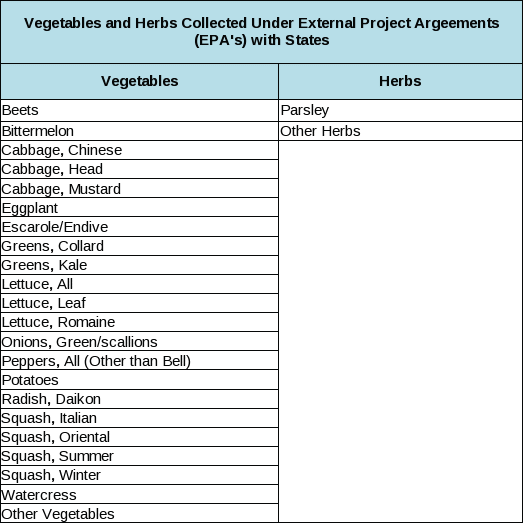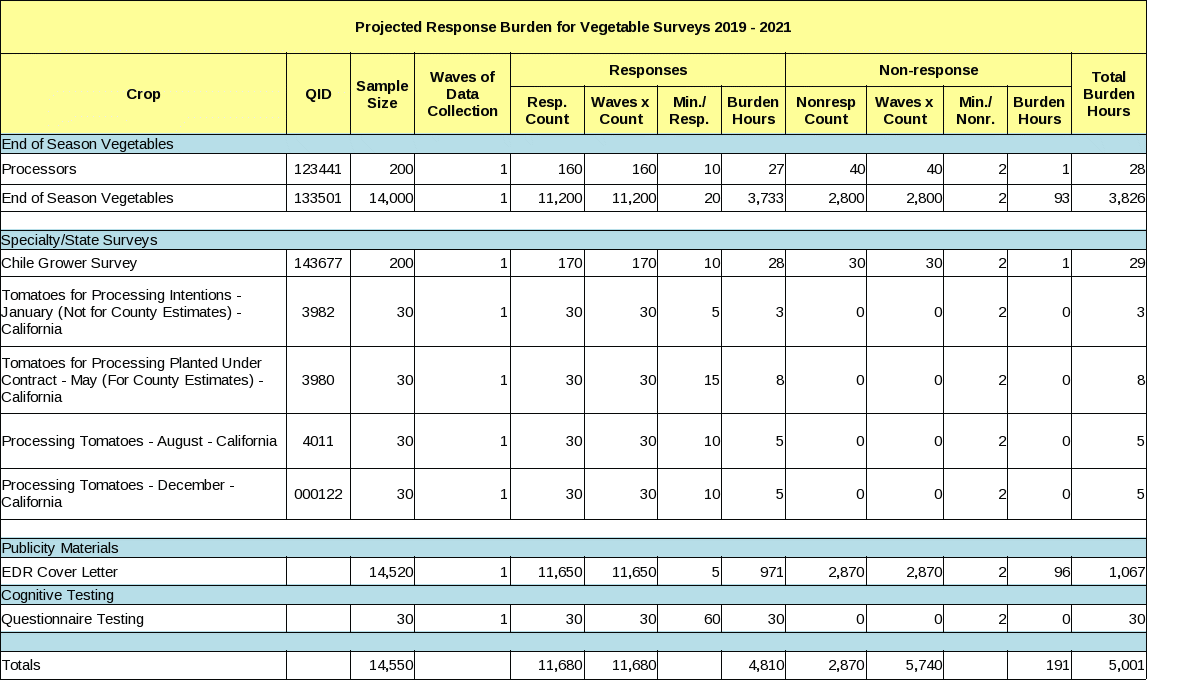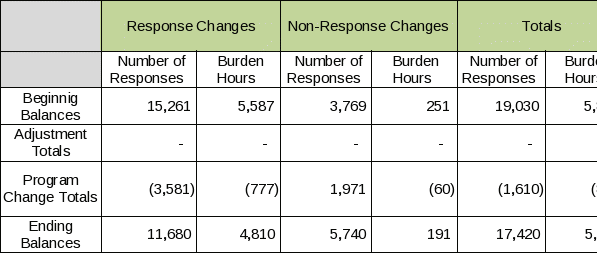0037-veg-19-SSA-July 19, 2019
0037-veg-19-SSA-July 19, 2019.docx
Vegetable Surveys
OMB: 0535-0037
Supporting Statement
VEGETABLE SURVEYS
OMB No. 0535-0037
A. JUSTIFICATION
This long-running docket is being submitted for an extension of 3 years. Numerous improvements are being made to this program in this renewal. The Vegetable Forecast surveys have been discontinued. Strawberries have been removed from this docket and will be included in the fruit docket along with the other berry commodities. There have been some changes to the commodities that are now included in this renewal along with the States included with each commodity. These changes are the result of our normal program review that takes place every five years, following the completion of the Census of Agriculture. The details can be found at this location
https://www.nass.usda.gov/Surveys/Program_Review/2019/Vegetable-Program.pdf.
1. Explain the circumstances that make the collection of information necessary. Identify any legal or administrative requirements that necessitate the collection. Attach a copy of the appropriate section of each statute and regulation mandating or authorizing the collection of information.
The primary objective of the National Agricultural Statistics Service (NASS) is to publish useful statistics related to agriculture. This includes estimates of crop and livestock production, prices, and disposition; economic and environmental statistics; and conducting the quinquennial Census of Agriculture. The Vegetable Surveys program obtains basic agricultural statistics for fresh market and processing vegetables in major producing states. Vegetable statistics are used by the U.S. Department of Agriculture to help administer programs and by growers, processors, and marketers in making production and marketing decisions. Estimates for the fresh market and processing vegetable program consists of 27 selected crops. Following the program review that occurred after the 2017 Census of Agriculture NASS decided that the vegetable forecast surveys would be discontinued, and only the end of season surveys would be conducted.
The vegetable program classifies vegetables by utilization; all crops can be used by both the fresh and processed markets.
The vegetable program surveys growers, who are contacted in November and asked to report acres planted and harvested, quantity of vegetables produced, and how much of their crop was sold through fresh markets or for processing along with the correlating prices.
Vegetable processors are surveyed in late November, and are asked for final acreage planted, harvested, and production
As part of the Agricultural Resource Management, Chemical Use, and Post-harvest Chemical Use Surveys (OMB docket number 0535-0218), NASS maintains databases on agricultural chemical use and related farm practices. The vegetable surveys in this docket provide base information for much of the data collected in that docket.
General authority for these data collection activities is granted under U.S. Code Title 7, Section 2204 which specifies that "The Secretary of Agriculture shall procure and preserve all information concerning agriculture which he can obtain ... by the collection of statistics ... and shall distribute them among agriculturists."
2. Indicate how, by whom, and for what purpose the information is to be used. Except for a new collection, indicate the actual use the agency has made of the information received from the current collection.
Data reported on vegetable inquiries are used by NASS to estimate acreage planted and harvested, yield/production, price, and utilization for the crops listed below as a part of the Federal vegetable program.

The following supplemental vegetable and herb data is collected under external project agreements with State cooperators. Rather than conduct two separate surveys, the additional data is collected using the same Federal questionnaires. The cooperators, reimburse NASS for the additional data collection and summary costs.

These estimates provide vital statistics for growers, processors, and marketers to use in making production and marketing decisions. Private industry forecasters use the data to track production levels for the industry. Federal and State agencies use the annual summary when developing and appraising government programs affecting the vegetable industry. Allied industries such as container manufacturers, chemical manufacturers, and plant breeders use the data in feasibility studies to assess the economic impact of products and define market size and location. Data have been provided to foreign governments interested in U.S. vegetable production and to extension specialists at land grant universities.
Some States have entered into cooperative agreements with NASS to include additional vegetables to the Federal program. These crops are significant to their State’s economy. The USDA Farm Service Agency and the Risk Management Agency will use NASS data for administering their programs and this supplemental data is needed to get a complete picture of the vegetable production in these States.
Survey results are used by the Economic Research Service (ERS) for the Vegetables and Pulses Outlook Report https://www.ers.usda.gov/publications/pub-details/?pubid=93032.
Vegetable data provides information to assist the Agricultural Marketing Service in the administration of market orders for tomatoes and onions. Another user of NASS data is the office of the U.S. Trade Representative, Executive Office of the President, to help administer their Generalized System of Preferences Program, which determines preferred imports from other countries. The International Trade Commission utilizes vegetable data in its studies of import relief.
3. Describe whether, and to what extent, the collection of information involves the use of automated, electronic, mechanical, or other technological collection techniques or other forms of information technology, e.g., permitting electronic submission of responses, and the basis for the decision for adopting this means of collection. Also describe any consideration of using information technology to reduce burden.
Beginning in 2013 NASS expanded its data collection modes for the vegetable surveys to include web-based data reporting. In 2018, just over four percent of the respondents completed the survey using the internet.
4. Describe efforts to identify duplication. Show specifically why any similar information already available cannot be used or modified for use for the purposes described in Item 2 above.
The National Agricultural Statistics Service cooperates with State Agricultural Departments and universities to conduct agricultural surveys. The surveys meet both State and Federal needs, thus eliminating duplication and minimizing reporting burden on the agricultural industry. These surveys are the only timely and reliable source of information on the vegetable industry at the national level. The statistics published are not available from any other source.
5. If the collection of information impacts small businesses or other small entities (Item 5 of OMB Form 83-I), describe any methods used to minimize burden.
Information from growers can be provided with a minimum of difficulty by the respondent and generally without having to consult their record books. Processors provide the requested information from their normal day-to-day operating records. Of the total sample size of 13,545 approximately 79% or 10,720 are considered to be small operations.
NASS recently conducted a complete review of the vegetable programs across the United States based on the results of the 2017 Census of Agriculture. This type of review is conducted once every five years. The primary purpose of this review is to ensure that NASS’ annual estimation program targets commodities and states that are the most relevant to U.S. agriculture based on the latest information available. The primary source of information used by NASS is the Census of Agriculture, since it is the most comprehensive. NASS also analyzed our annual vegetable estimates, and compared them with administrative data from the Farm Services Agency (FSA) before any program changes were made.
When determining which states should be included in any commodity program, NASS selects states that, in aggregate, account for approximately 90-95 percent of the U.S. production. In some cases it would be inefficient to reach this level and therefore coverage could be slightly lower.
6. Describe the consequence to Federal program or policy activities if the collection is not conducted or is conducted less frequently, as well as any technical or legal obstacles to reducing burden.
Collecting data less frequently would eliminate data needed to keep the agricultural industry abreast of changes at the State and national level. Timing and frequency of the various reports have evolved to meet the needs of customers and yet minimize the burden on the reporting public. NASS has been undertaking a major standardization effort since 2012 to consolidate many of the vegetable questionnaires across all States.
7. Explain any special circumstances that would cause an information collection to be conducted in a manner inconsistent with the general information guidelines in 5 CFR 1320.5.
There are no special circumstances associated with this information collection.
8. Provide a copy and identify the date and page number of publication in the Federal Register of the agency's notice, required by 5 CFR 1320.8 (d), soliciting comments on the information collection prior to submission to OMB. Summarize public comments received in response to that notice and describe actions taken by the agency in response to these comments.
The Notice soliciting comments was published in the Federal Register on April 17, 2019 on pages 15999 - 16000. NASS did not receive any public comments on this renewal request.
Describe efforts to consult with persons outside the agency to obtain their views on the availability of data, frequency of collection, the clarity of instructions and record-keeping, disclosure, or reporting format (if any), and on the data elements to be recorded, disclosed, or reported.
NASS is in frequent contact with growers and processors to stay informed about the vegetable industry. NASS also frequently consults with other government agencies such as the Foreign Agricultural Service, Economic Research Service, and Agricultural Marketing Service. Other groups NASS has consulted with are the Grocery Manufacturer’s Association, the Produce Marketing Association, United Fresh Produce Association, and the National Onion Association.
9. Explain any decision to provide any payment or gift to respondents.
There are no payments or gifts to respondents.
10. Describe any assurance of confidentiality provided to respondents and the basis for the assurance in statute, regulation, or agency policy.
Questionnaires include a statement that individual reports are confidential. U.S. Code Title 18, Section 1905; U.S. Code Title 7, Section 2276; and Public Law 107-347, Title V (CIPSEA) provide for confidentiality of reported information. All employees of NASS and all enumerators hired and supervised under a cooperative agreement with the National Association of State Departments of Agriculture (NASDA) must read the regulations and sign a statement of compliance.
Additionally, NASS employees and NASS contractors comply with the OMB implementation guidance document, “Implementation Guidance for Title V of the E-Government Act, Confidential Information Protection and Statistical Efficiency Act of 2002 (CIPSEA).” CIPSEA supports NASS’s pledge of confidentiality to all respondents and facilitates the agency’s efforts to reduce burden by supporting statistical activities of collaborative agencies through designation of NASS agents, subject to the limitations and penalties described in CIPSEA.
The following confidentiality pledge statement will appear on all NASS questionnaires.
The information you provide will be used for statistical purposes only. Your responses will be kept confidential and any person who willfully discloses ANY identifiable information about you or your operation is subject to a jail term, a fine, or both. This survey is conducted in accordance with the Confidential Information Protection provisions of Title V, Subtitle A, Public Law 107-347 and other applicable Federal laws. For more information on how we protect your information please visit: https://www.nass.usda.gov/confidentiality.
11. Provide additional justification for any questions of a sensitive nature.
There are no questions of a sensitive nature.
12. Provide estimates of the hour burden of the collection of information. The statement should indicate the number of respondents, frequency of response, annual hour burden, and an explanation of how the burden was estimated. If this request for approval covers more than one form, provide separate hour burden estimates for each form and aggregate the hour burdens in Item 13 of OMB Form 83-I. Provide estimates of annualized cost to respondents for the hour burdens for collections of information, identifying and using appropriate wage rate categories.
This renewal has a sample size of 13,550, a total number of 16,220 responses and a total of 4,655 burden hours.
Average minutes per response for the vegetable surveys are based on the amount of data asked on each questionnaire and the time needed for telephone follow-ups. Total hours of burden are shown in the table below.
The cost to the public of completing a questionnaire is assumed to be comparable to the hourly rate of those requesting the data. Reporting time of 5,001 hours is multiplied by $36.84 per hour for a total cost to the public of $184,236.84.
NASS uses the Bureau of Labor Statistics’ Occupational Employment Statistics (most recently published on March 29, 2019 for the previous May) to estimate an hourly wage for the burden cost. The May 2018 mean wage for bookkeepers was $20.25. The mean wage for farm managers was $38.43. The mean wage for farm supervisors was $24.42. The mean wage of the three is $27.70. To calculate the fully loaded wage rate (includes allowances for Social Security, insurance, etc.) NASS will add 33% for a total of $36.84 per hour.

13. Provide an estimate of the total annual cost burden to respondents or record-keepers resulting from the collection of information.
There are no capital/start-up or ongoing operation/maintenance costs associated with this information collection.
14. Provide estimates of annualized cost to the Federal government; provide a description of the method used to estimate cost which should include quantification of hours, operational expenses, and any other expense that would not have been incurred without this collection of information.
The estimated total cost to the Federal government for the vegetable program will remain at $1.5 million. Approximately $1,275,000 will go to federal salaries, $113,000 will go to NASDA enumerators for data collection and $112,000 will go to printing, postage and other miscellaneous expenses.
15. Explain the reasons for any program changes or adjustments reported in Items 13 or 14 of the OMB Form 83-I (reasons for changes in burden).
Several changes have occurred since the previous approval. NASS has cut out the forecast surveys (asparagus, onions, and strawberries) and the end of the season strawberry and onion surveys due to the post census reviews. In addition several commodities have been removed from the remaining questionnaires. Strawberries have been moved to the Fruit and Nut docket (0535-0039) and sweet potatoes have been moved from the Field Crop docket (0535-0002) to this docket. Asparagus and onion data is still being collected it has just been combined into the End of Season questionnaire instead of being collected in a standalone questionnaire. The Chili pepper, processor survey was dropped from the cooperative program with New Mexico.

16. For collections of information whose results will be published, outline plans for tabulation and publication. Address any complex analytical techniques that will be used. Provide the time schedule for the entire project, including beginning and ending dates of the collection of information, completion of report, publication dates, and other actions.
The vegetable surveys obtain data from the major producing States for all of the major commodities in their State. Samples are selected nationally for each State based on targeting the particular commodity of interest. Vegetable data are collected by the National Operations Division (NOD) and within the Regional Field Offices (RFOs). The data are summarized nationally with all States using the same summary and receiving consistent indications across all States and commodities. All States participate in the vegetable program and data are published for both the fresh market vegetables and the processed vegetables, following the NASS confidentiality rules.
The forecast surveys for fresh market and processing vegetables have been discontinued.
The annual end of season vegetable release contains estimates set for acreage, yield, and total production price for all vegetables in the estimation program.
Below is the link to the Annual release:
Below is the link to the California Process Tomato Reports:
Below is the link to the New Mexico Chile Pepper Reports:
Regional, State and Headquarters statisticians use the same Estimation Manual which contains standard analysis and estimation procedures.
17. If seeking approval to not display the expiration date for OMB approval of the information collection, explain the reasons that display would be inappropriate.
There is no request for approval of non-display of the expiration date.
18. Explain each exception to the certification statement identified in Item 19, “Certification for Paperwork Reduction Act Submissions” of OMB Form 83-I.
There are no exceptions to the certification statement.
July 2019
| File Type | application/vnd.openxmlformats-officedocument.wordprocessingml.document |
| Author | David Hancock |
| File Modified | 0000-00-00 |
| File Created | 2021-01-14 |
© 2025 OMB.report | Privacy Policy